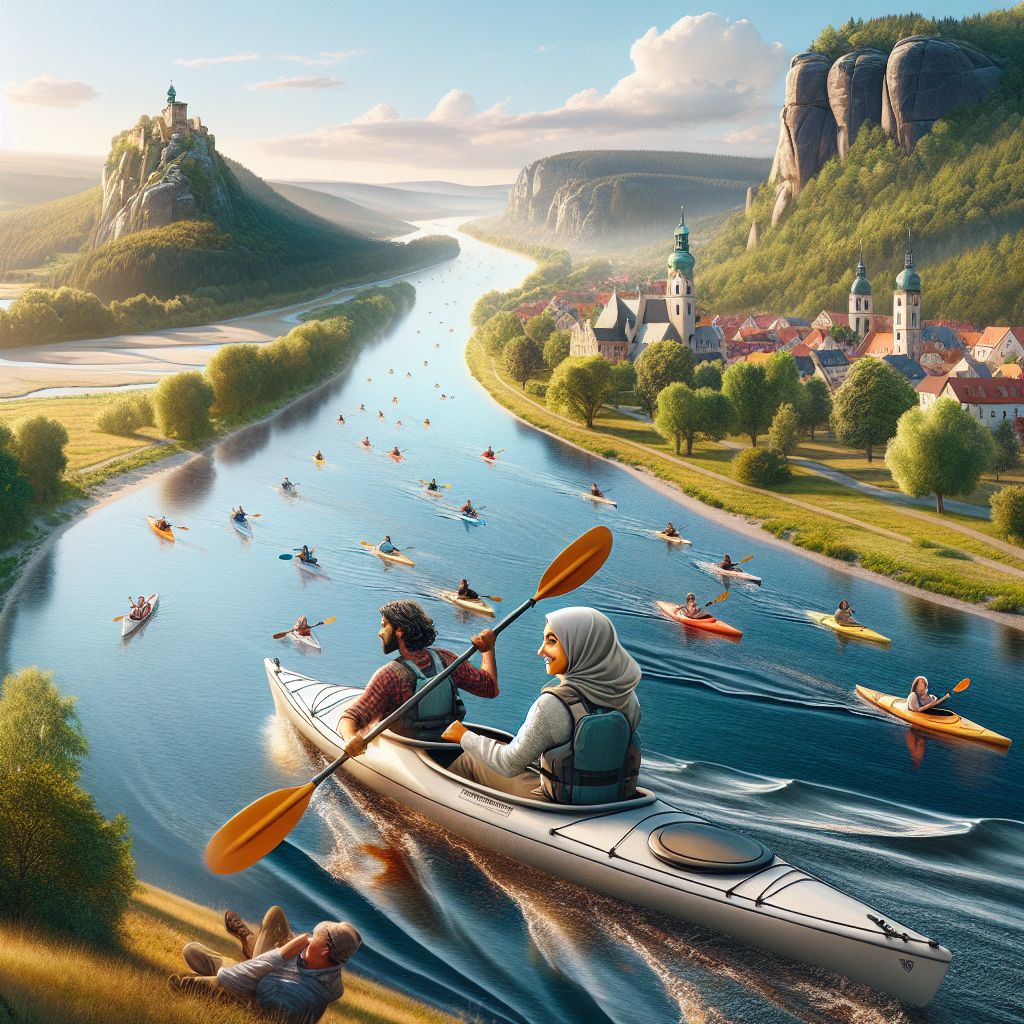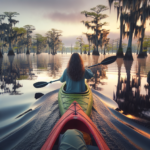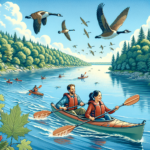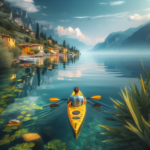Kayaking in Elbe River, Germany/Czech Republic
Introduction to Kayaking
Kayaking is a thrilling outdoor activity that has gained immense popularity worldwide. It offers a unique way to explore nature, combining physical exercise with the serenity of gliding over water. Whether you’re navigating through calm lakes, challenging river rapids, or coastal waters, kayaking provides an exhilarating experience that appeals to adventurers of all skill levels. The sport’s accessibility and the minimal equipment required make it an attractive option for those looking to connect with nature.
In this article, we will spotlight the unique features of kayaking in the Elbe River, which flows through Germany and the Czech Republic. This river offers a fantastic destination for kayaking enthusiasts, boasting a mix of scenic beauty, historical significance, and diverse kayaking conditions. Our goal is to provide a comprehensive guide to help you plan your kayaking adventure on the Elbe River.
Kayaking in the Elbe River is a unique experience due to its diverse landscapes, ranging from serene countryside to bustling urban areas. The river’s historical and cultural significance adds an extra layer of intrigue, making it more than just a kayaking trip but a journey through time. Whether you’re a seasoned kayaker or a beginner, the Elbe River offers something for everyone.
In the following sections, we will delve into the specifics of kayaking in the Elbe River, including the best spots, conditions, safety regulations, and more. By the end of this article, you’ll have all the information you need to embark on an unforgettable kayaking adventure in this remarkable location.
Overview of Kayaking in Elbe River, Germany/Czech Republic
The Elbe River is one of Central Europe’s major rivers, flowing through the Czech Republic and Germany before emptying into the North Sea. Its journey spans approximately 1,094 kilometers, offering a diverse range of kayaking experiences. The river’s geography includes mountainous regions, rolling hills, and flat plains, providing varied scenery and kayaking conditions.
The climate along the Elbe River is generally temperate, with warm summers and cold winters. This makes spring and summer the best times to visit for kayaking, as the weather is more predictable and the water levels are ideal. The river’s historical significance is also noteworthy, with many ancient towns and cities along its banks, offering a rich cultural experience.
Accessing the Elbe River for kayaking is relatively straightforward. Major cities like Dresden in Germany and Ústí nad Labem in the Czech Republic serve as excellent starting points. Both cities are well-connected by road and rail, making it easy for visitors to reach the river. Additionally, there are numerous entry points along the river, allowing for flexible trip planning.
Overall, the Elbe River offers a unique blend of natural beauty, historical significance, and accessible kayaking conditions. Whether you’re looking to explore ancient castles, enjoy the tranquility of nature, or challenge yourself with varying water conditions, the Elbe River has something to offer every kayaker.
Kayaking Conditions in Elbe River, Germany/Czech Republic
The Elbe River offers a variety of water conditions that cater to different kayaking preferences. The upper reaches of the river, particularly in the Czech Republic, feature more challenging conditions with faster currents and occasional rapids. As the river flows into Germany, it becomes wider and calmer, making it suitable for leisurely paddling and beginners.
Weather conditions along the Elbe River can vary significantly throughout the year. Spring and summer are the most favorable seasons for kayaking, with temperatures ranging from 15°C to 25°C. During these months, the water levels are generally stable, and the weather is more predictable. Autumn can also be a good time to visit, although the weather can be more variable.
Tides and water currents are important factors to consider when planning a kayaking trip on the Elbe River. While the river is not tidal, water levels can fluctuate due to rainfall and snowmelt, particularly in the spring. It’s essential to check local water level reports and weather forecasts before embarking on your trip to ensure safe and enjoyable conditions.
Environmental factors such as wind and water temperature can also impact your kayaking experience. Wind can create choppy conditions, particularly in wider sections of the river, while water temperatures can vary depending on the season. Wearing appropriate gear, such as a wetsuit or drysuit, can help you stay comfortable and safe during your kayaking adventure.
Top Spots for Kayaking in Elbe River, Germany/Czech Republic
The Elbe River boasts several top spots for kayaking, each offering unique features and experiences. One of the most popular sections is the stretch between Dresden and Meissen in Germany. This area is known for its picturesque landscapes, historic castles, and charming villages. The calm waters make it ideal for beginners and those looking for a relaxing paddle.
Another excellent spot is the Saxon Switzerland National Park, located near the German-Czech border. This area features stunning sandstone cliffs, lush forests, and diverse wildlife. The river here offers a mix of calm sections and gentle rapids, making it suitable for intermediate kayakers. The best time to visit is during the spring and summer when the weather is mild and the scenery is at its most vibrant.
In the Czech Republic, the section of the Elbe River near the town of Litoměřice is a must-visit. This area is known for its beautiful vineyards, historic architecture, and serene riverbanks. The waters here are generally calm, making it a great spot for leisurely paddling and enjoying the local scenery. Autumn is an excellent time to visit, as the vineyards are in full harvest, adding a unique charm to the landscape.
For those seeking a more challenging experience, the upper reaches of the Elbe River near the town of Děčín in the Czech Republic offer faster currents and occasional rapids. This section is best suited for experienced kayakers looking for an adrenaline rush. The best time to visit is during the late spring and early summer when water levels are higher, providing more exciting conditions.
Safety and Regulations
Safety is paramount when kayaking on the Elbe River. Local regulations require all kayakers to wear a life jacket at all times. It’s also recommended to carry a whistle, a first aid kit, and a waterproof map of the area. Familiarizing yourself with the river’s layout and potential hazards can help you navigate safely.
Before setting out, it’s essential to check local weather and water level reports. Sudden changes in weather can impact water conditions, making it crucial to stay informed. Additionally, it’s advisable to let someone know your planned route and expected return time. This ensures that help can be summoned quickly in case of an emergency.
Emergency situations can arise unexpectedly, so it’s important to be prepared. Knowing basic rescue techniques, such as how to perform a self-rescue or assist a fellow kayaker, can be invaluable. Carrying a mobile phone in a waterproof case can also be a lifesaver, allowing you to call for help if needed.
Respecting local wildlife and natural habitats is also crucial for a safe and enjoyable kayaking experience. Avoid disturbing animals and plants, and follow designated routes to minimize your impact on the environment. By adhering to these guidelines, you can help preserve the beauty and biodiversity of the Elbe River for future generations.
Amenities and Accommodations
The Elbe River region offers a range of amenities to enhance your kayaking experience. Numerous rental facilities provide kayaks, paddles, and safety gear, making it easy for visitors to get started. Guided tours are also available, offering expert knowledge and insights into the river’s history and natural features.
Accommodation options along the Elbe River are plentiful, catering to various preferences and budgets. From camping sites and hostels to charming bed-and-breakfasts and luxury hotels, there’s something for everyone. Many accommodations are located near popular kayaking spots, providing convenient access to the river.
For those who prefer a more immersive experience, several campgrounds are situated along the riverbanks. These sites offer basic amenities such as restrooms, showers, and picnic areas, allowing you to enjoy the great outdoors while staying comfortable. Some campgrounds also provide kayak storage facilities, making it easy to secure your equipment overnight.
In addition to kayaking, the Elbe River region offers a variety of recreational activities. Hiking and cycling trails are abundant, allowing you to explore the surrounding landscapes on foot or by bike. Local attractions such as historic castles, museums, and vineyards provide opportunities for cultural enrichment and relaxation on days when you’re not on the water.
Environmental Considerations
Preserving the natural habitats and wildlife of the Elbe River is essential for maintaining its beauty and ecological balance. Practicing eco-friendly kayaking is crucial to minimizing your impact on the environment. This includes avoiding littering, using biodegradable products, and respecting wildlife by keeping a safe distance.
One of the key principles of eco-friendly kayaking is to leave no trace. This means packing out all trash, including food wrappers and beverage containers, and disposing of them properly. Using reusable water bottles and containers can also help reduce waste and minimize your environmental footprint.
Supporting local conservation efforts is another way to contribute to the preservation of the Elbe River. Many organizations and projects focus on protecting the river’s ecosystems and promoting sustainable tourism. By participating in these initiatives or making a donation, you can help ensure the long-term health of the river and its surroundings.
Finally, educating yourself and others about the importance of environmental stewardship can have a lasting impact. Sharing your knowledge and experiences with fellow kayakers and encouraging responsible practices can help foster a community of environmentally conscious adventurers who are committed to preserving the natural beauty of the Elbe River.
Highlights
When comparing kayaking in the Elbe River to other popular kayaking destinations, several unique features stand out. The river’s diverse landscapes, ranging from mountainous regions to flat plains, offer a variety of kayaking experiences that cater to different skill levels. This diversity is not commonly found in many other kayaking locations.
The Elbe River’s rich historical and cultural significance also sets it apart. Paddling through ancient towns and cities, you can explore historic castles, churches, and landmarks that provide a glimpse into the region’s past. This combination of natural beauty and cultural heritage creates a unique and enriching kayaking experience.
Biodiversity is another highlight of the Elbe River. The river and its surrounding areas are home to a wide range of plant and animal species, including several rare and endangered species. This makes kayaking on the Elbe River an excellent opportunity for wildlife enthusiasts and nature lovers to observe and appreciate the region’s unique ecosystems.
Overall, the Elbe River offers a kayaking experience that is both diverse and enriching. Its unique blend of natural beauty, historical significance, and biodiversity makes it a standout destination for kayaking enthusiasts. Whether you’re seeking adventure, relaxation, or cultural exploration, the Elbe River has something to offer.
FAQ Section
- What is the best season to go kayaking on the Elbe River? The best seasons are spring and summer, from April to September, when the weather is mild and water levels are stable.
- Are there beginner-friendly spots for kayaking on the Elbe River? Yes, sections like Dresden to Meissen and Litoměřice offer calm waters suitable for beginners.
- What should I bring for a kayaking trip on the Elbe River? Essential items include a life jacket, paddle, waterproof map, first aid kit, and appropriate clothing for the weather.
- Are kayak rentals available, and what are the costs? Yes, kayak rentals are available at various locations along the river. Costs typically range from €20 to €50 per day, depending on the type of kayak and equipment.
- How can I participate in local conservation efforts? You can support local conservation projects by making donations or volunteering with organizations focused on preserving the Elbe River’s ecosystems.
- Are guided kayaking tours available? Yes, guided tours are available and often include equipment rental, safety briefings, and insights into the river’s history and natural features.
- What safety measures are in place for kayakers on the Elbe River? Local regulations require wearing life jackets, and it’s recommended to carry a whistle, first aid kit, and mobile phone in a waterproof case.
Final Thoughts
Kayaking in the Elbe River, Germany/Czech Republic, is a premier destination for kayaking enthusiasts. Its diverse landscapes, rich history, and unique biodiversity make it an exceptional place to explore by kayak. Whether you’re a seasoned paddler or a beginner, the Elbe River offers a range of experiences that cater to all skill levels.
As you plan your kayaking adventure, remember to respect local guidelines and conservation efforts. Practicing eco-friendly kayaking and supporting local conservation projects can help preserve the river’s natural beauty and ecological balance for future generations.
In conclusion, the Elbe River provides an unparalleled kayaking experience that combines adventure, relaxation, and cultural exploration. We invite you to discover the beauty and thrill of kayaking in this remarkable location and create lasting memories on the waters of the Elbe River.









